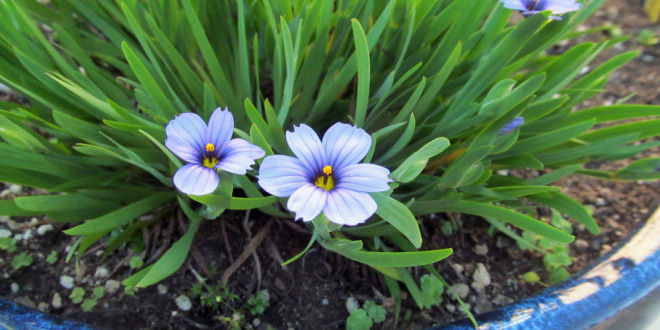Sisyrinchium angustifolium is noted for its violet-blue flowers and branched flowering stems. Though their foliage is grass-like, the blue-eyed grasses belong to the iris family not the grass family. It is native to southeast USA where it occurs in damp open woods, slopes and along stream banks. It is a clump-forming perennial that features a tuft of narrow grass-like leaves (to 3/16″ wide) typically growing to 12″ (less frequently to 20″) tall. Clusters of violet-blue flowers (to 1/2″ across), each with 6 pointed tepals and a yellow eye, appear in spring on stalks growing from leaf-like bracts atop usually branched flowering stems which are distinctively flattened.
First planted in my sunnyvale garden in 2015.
The main toxic component is the resinoid irisin.
Details
Genus: Sisyrinchium (sis-ee-RINK-ee-um) (Info)
Species: angustifolium (an-gus-tee-FOH-lee-um) (Info)
Synonym:Sisyrinchium bermudiana
Synonym:Sisyrinchium graminoides
Synonym:Sisyrinchium gramineum
Synonym:Sisyrinchium bermudianum
6 vendors have this plant for sale.
41 members have or want this plant for trade.
View this plant in a garden
Category:
Perennials
Height:
12-18 in. (30-45 cm)
Spacing:
9-12 in. (22-30 cm)
Hardiness:
USDA Zone 3a: to -39.9 °C (-40 °F)
USDA Zone 3b: to -37.2 °C (-35 °F)
USDA Zone 4a: to -34.4 °C (-30 °F)
USDA Zone 4b: to -31.6 °C (-25 °F)
USDA Zone 5a: to -28.8 °C (-20 °F)
USDA Zone 5b: to -26.1 °C (-15 °F)
USDA Zone 6a: to -23.3 °C (-10 °F)
USDA Zone 6b: to -20.5 °C (-5 °F)
USDA Zone 7a: to -17.7 °C (0 °F)
USDA Zone 7b: to -14.9 °C (5 °F)
USDA Zone 8a: to -12.2 °C (10 °F)
USDA Zone 8b: to -9.4 °C (15 °F)
Sun Exposure:
Sun to Partial Shade
Danger:
Unknown – Tell us
Bloom Color:
Medium Blue
White/Near White
Bloom Time:
Mid Spring
Foliage:
Grown for foliage
Herbaceous
Other details:
Average Water Needs; Water regularly; do not overwater
Soil pH requirements:
6.6 to 7.5 (neutral)
7.6 to 7.8 (mildly alkaline)
Patent Information:
Non-patented
Propagation Methods:
By dividing rhizomes, tubers, corms or bulbs (including offsets)
From seed; direct sow outdoors in fall
Seed Collecting:
Bag seedheads to capture ripening seed
Allow pods to dry on plant; break open to collect seeds
Allow seedheads to dry on plants; remove and collect seeds
Properly cleaned, seed can be successfully stored
Read more: http://davesgarden.com/guides/pf/go/491/#ixzz3Urr7CToW








